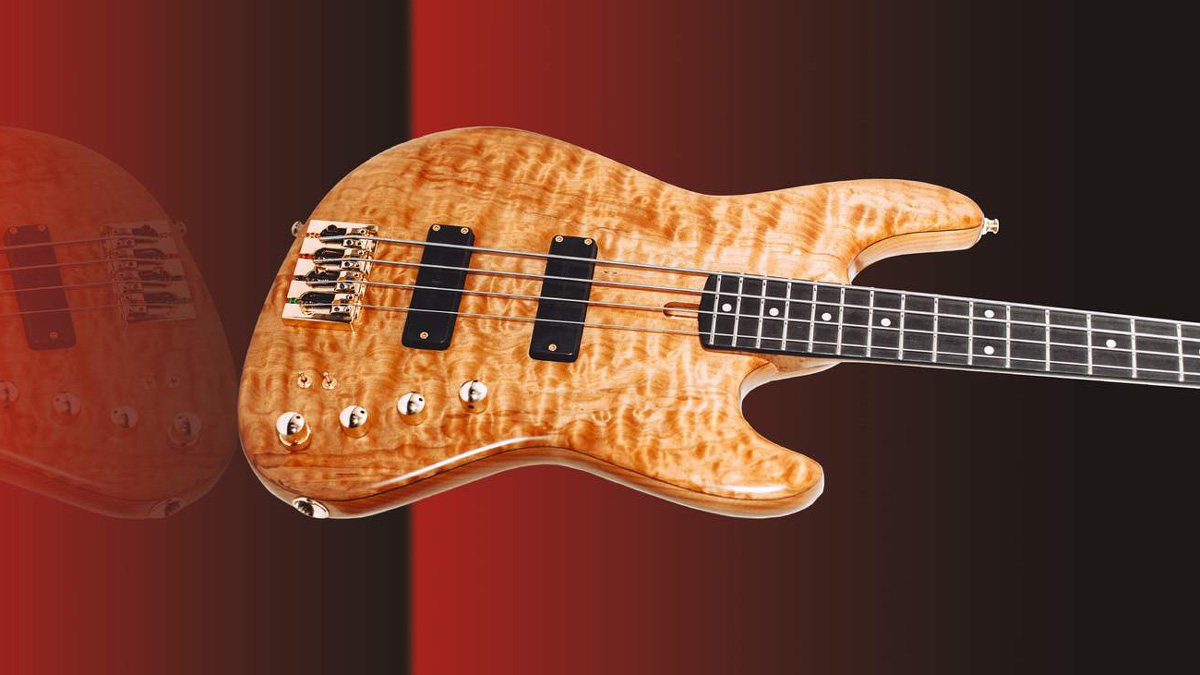MusicRadar Verdict
As much of a ‘steal’ as a £2200 bass can be.
Pros
- +
Excellent tone range and component quality.
Cons
- -
Nothing.
MusicRadar's got your back
When a luthier announces a new ‘affordable’ range of instruments, with specific components and options, you wonder if they will lack a little of the magic that makes said luthier’s instruments so special.
These were our thoughts when this bass was presented to us at LBGS 2018 for our appraisal, as it marked the launch of a new range of instruments for Anaconda owner Andrew Taylor-Cummings. Of course, £2200 is still a lot of money - but at a show where instruments costing in excess of £5000 can be found on every corner, we wondered how he’s brought it in on budget. Read on and find out.
Build
On first viewing, all of the familiar Anaconda hallmarks seem to be in place: sumptuous timbers, a well-matched pickup and circuitry package, high-quality hardware and tonal options to satisfy the most animated control fiddler. The familiar Jazz-inspired offset body shape uses an alder core, stained poplar veneer and a maple top with seashell-like figuring. If that’s not enough for you, the roasted birdseye maple neck and ebony fingerboard will send you overboard.
The neck is tightly connected to the body courtesy of the five-bolt attachment, while the hand-cut brass nut, Luminlay front and side position markers and signature on the rear of the headstock indicate that corners haven’t been cut, as far as we can see. The setup and finishing are exemplary, while the Jazz-like neck dimensions and C-shaped profile are extremely comfortable to get to grips with. With 19mm string spacing and a pleasant continuity across the whole neck, there is much to enjoy here. The oil-finished neck and satin polyester body provide an enjoyable playing experience.
With gold Hipshot hardware throughout, the visuals work well with the timber colouring, even down to the gold-coloured aluminium bolts used for pickup height adjustments. A simple control layout comprising of volume, balance, mid and stacked bass/treble controls are supplemented with selector switches for series, single-coil and parallel operation from each of the Bartolini humbucking pickups. Should you need it, a passive option can be activated by pulling the volume control.
Sounds
With a Glockenklang preamp and Bartolini pickups, Andrew has picked an electronics package that provides definition and articulation with a fair degree of presence. For those who wonder if there will be enough ‘oomph’ on tap, have no fear. This bass is no shrinking violet and its output is mightily impressive. The core tone is naturally solid with a noticeable bark, and the tonal performance is impressive across the whole neck.
For those of a slapping persuasion, a throaty percussive thump is easily obtained with little bother, and if rounded finger-tones or the tight honky tones that keep a band bubbling along are required, you will find those fairly quickly. Both pickups have their respective tones based on their positioning, while the EQ options provide extra clarity in the top end and extra power in the low register. The mid-EQ is well voiced and gives your delivery a little extra push should you need it.
Want all the hottest music and gear news, reviews, deals, features and more, direct to your inbox? Sign up here.
The selector switches give you some extra options that you may find useful. Turning either pickup into a single-coil unit instantly changes the tonal character; if you want those ever-familiar Jazz tones, you know what to do. Changing either pickup from series to parallel operation and vice versa is dramatic but useful, especially if you need a less robust and forthright tone for specific pieces of music.
Clearly, this bass has an extensive tonal palette - and although a little experimentation is required to get used to the tones on offer, once you’ve got your head around how best to use the options at your disposal, we’re sure you’ll agree that you have a tone monster in your hands. We’re pleased to report that the passive option is decent too - this is no emergency backup option but a fine-sounding passive display that works very well with no drop in output.
It looks and sounds as if Andrew has potentially hit a winning formula here. By restricting the options available to the customer, he may well have found a useful, mid-budget combination. Sometimes, the custom route can be overly complicated; after all, there is a reason why some of the best bass sounds come from specific, tried-and-trusted material combinations. Very impressive.
